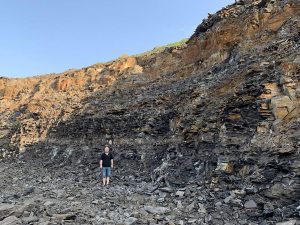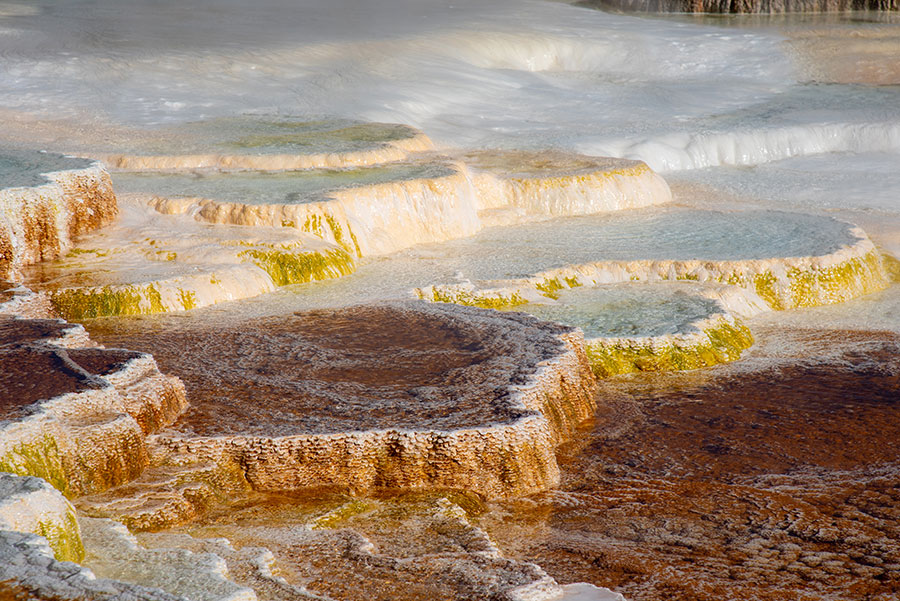Fossils offer a window into the palaeoenvironment, which is critical for our understanding of environmental change. Dr Jiyuan You (Yulin University, China) and Professor Yiqun Liu (Northwest University, China) are using the fossilised remains of ancient cod, found in phosphate rocks of the Ordos Basin, China, to gain new insights into a unique palaeoenvironment. The reconstruction of a new species highlights a Late Triassic hydrothermal system that arose owing to intense tectonics and volcanic activity, and provides new understanding into nutrient cycling and ecosystem evolution in deep lakes.
Following death, most living things decompose, the various elements and molecules making up their bodies slowly returning to the Earth. However, given the right time and the right place, when a specific set of conditions are met, a ‘lucky’ plant or animal can be forever preserved. These fossils offer a window into the palaeoenvironment, which is critical for our understanding of environmental change.
At Northwest University (China), Dr Jiyuan You and his colleagues (Prof Yiqun Liu, Yongxiang Li, Dingwu Zhou, and Shanshan Song) are using fish fossils to gain new insights into a unique palaeoenvironment. Focused on the remains of ancient cod in the Ordos Basin of north central China, the team are revealing new details of extreme organisms in hydrothermal environments; furthering our understanding of hydrothermal deposition, and of nutrient cycling and ecosystem evolution in deep lakes.


A window to a past world
In general, during the fossilisation process, soft tissue rots away, leaving harder skeletal material to be buried by sediments. Over time, as more and more sediments are deposited, the weight of the overlying material increases and the sediments lithify (i.e., turn to rock). The skeleton itself either lithifies too, or dissolves, leaving a mould within the rock. In the case of the latter, as mineral-rich fluids circulate through the crust, they leave deposits in these cavities, and in time these mineral deposits take on the exact form of the mould. With the passage of geological time (i.e., millions of years), the sedimentary rocks may become re-exposed at the surface (for example, through uplift during continental collision and mountain building), where the ravages of wind and water erode them away, once again exposing the now-fossilised creatures of a bygone era.
“Fossilisation is a surprisingly rare event, with the vast majority of fossils found in deposits formed in water — mostly marine, but also lakes or rivers.”
Fossilisation is a surprisingly rare event, with the vast majority of fossils found in deposits formed in water (mostly marine, but also lakes or rivers). In such settings, the deceased animal or plant sinks quickly through the water, where the lack of oxygen slows the rotting process just enough to allow the overlying sediments to accumulate. Fossil burials can be roughly divided into two types: in situ (i.e., the animal is buried where it died) and off-site (i.e., after death, the animal is transported to a new location, usually by way of water action). Inland fish are limited to inland waters, and their fossils are usually buried in situ; as such, their distribution is strictly limited. Therefore, fish fossils record important information about the palaeoenvironment, including climate, water system, elevation, and other factors. Moreover, the bones of fish are made up of many parts, and as such they are particularly sensitive to different sedimentary environments.


Ancient cod of the Ordos basin
The Ordos Basin is a multicycle sedimentary basin located in north central China. Owing to a long period of continuous sedimentation during the Late Triassic (227 to 220 Ma, or million years ago), some fossils from the Ordos Basin record the entire evolutionary process of occurrence, development, productivity, decline, and extinction. The Triassic, a period of the Mesozoic era, was marked by an abundance of fish species. Among these, the ancient cod belong to a group of fish characterised by having a backbone, and to a subclass that have radial fins. They are the most representative of the primitive radial fin fish, but became extinct in the Early Cretaceous (145 to 100 Ma).


Triassic fish have long been identified in the Ordos Basin, but most finds have been of fragments. However, Dr You and his colleagues have been able to identify almost-whole ancient cod from the area. Samples were found in two main locations within high-quality oil bearing rocks of the Ordos Basin:
- Bawangzhuang village on the southern edge of the Ordos Basin, where the fossils developed in phosphate rock surrounded by terrigenous clastic sediments (that is, sediments made of rock fragments eroded from the land), volcaniclastic sediments (sediments of volcanic origin, such as pyroclastic material or ash), and hot water deposits;
- The Tongchuan area on the southern edge of the Ordos Basin, where ancient cod fossils manifest mainly as phosphorous nodules within the deformed bedding of hydrothermal sedimentary rocks.
The team used a variety of methods to analyse the fossilised cod. First, the fossil material was removed from the phosphoritic rocks using acetic acid. Some samples were then used to create thin sections—30 μm slithers off rock attached to a glass slide—allowing the team to investigate their microstructures and mineral composition using both optical microscopes and high powered electron microscopes. Other samples were sprayed with a thin layer of gold or carbon—to make them conductive—allowing their 3D form to be viewed using a scanning electron microscope. These powerful electron-based techniques allow the analysis of trace elements on the order of parts per million, and structural features on the order of micrometres (a human hair is approximately 70 μm wide, and there are 1000 μm in a millimetre).
Most of the fish fossils identified by Dr You and his colleagues are beautifully preserved. The team found that while no single fossil was completely intact, the parts of their structure were always found in their original locations relative to each other; suggesting that, after burial, disastrous events caused the fossils to break. The large number of samples, their morphological features, the sedimentary environment (deep-lake black mudstones with horizontal bedding developed), and lack of any preferred orientation all suggest in situ burial; even difficult-to-preserve structures—for example, teeth and parasphenoid bones, both found in the skull—are well preserved, while the scales remain neatly arranged.


The final output of this research was a near-complete model of an ancient cod, complete with scales but missing a head; in addition, the team were able to produce a cross section of the fish body. The fish has a long spindle-shaped body (2–10 cm), a long dorsal fin base, a rear-facing gap between the ventral fin and anal fins, thick fins, small decorative spine scales, inclined hanging bones, high gillcap bones, small scales and a number of horizontal scales. The genus and species of the fossil, Triassodus and tongchuanlepis, respectively, represent the age and location of the strata in which they were found.
“This work has far reaching implications in both paleoenvironmental reconstruction, and in improving our understanding of evolution in extreme environments.”
Reconstructing the palaeoenvironment
Comparison with other species from the Ordos Basin, and in particular the small size of these ancient cod (generally less than 10 cm) confirm that they represent a new species. The compositions of the samples are dominated by P, Si, and Ca, while trace element analysis showed large variations in Cs, Rb, Th, Ta, Pb, Zr, and Y, along with significantly elevated Sr and U. Together, these data suggest that the fossilised cod formed within a hot, hydrothermal environment. This is consistent with the results of previous studies that have identified palaeo-hydrothermal vents, and which have shown that the study area has experienced four magmatic-hydrothermal episodes. Dr You and his colleagues suggest that catastrophic geological events associated with intense tectonic and volcanic activity caused hydrothermal activity at the bottom of the lake. This unique environment allowed the species to emerge, but soon thereafter to die out.

This work has far reaching implications in both paleoenvironmental reconstruction, and in improving our understanding of evolution in extreme environments. Moreover, the discoveries of Dr You and his colleagues will allow for the comparative study of Late Triassic fish across Asia, North America, and Oceania, which is of great significance for revealing spatial changes in the ecological environment during this time.
Have similar fossils been found associated with other hydrothermal deposits around the world?
The Triassic period of the Mesozoic era was a very prosperous interval for fish. In the Nevada region of the United States, the Colombian region of Canada, the Spitzbergen region of the Arctic, the German basin in Europe, and the St. George Mountain region at the border of Switzerland and Italy, extremely abundant marine fish fossils have been found (David 1983; G.A. 1902). In addition, there are fish fossils found in the terrestrial strata of the Triassic, including Myriolepis from the Upper Triassic in Australia (Traquair 1893; Gardiner 1984), Turseodus from the Upper Triassic in the United States (Schaeffer 1952, 1967), and Shuniscus from the Upper Triassic in Sichuan, China (Su 1983). However, I have not found any fish fossils related to lacustrine hydrothermal deposition. Researchers studied the biome of modern oceanic hydrothermal vents. The hydrothermal vent biome contains fish. Our team tried to complete a comparative study of the two.
References
- You, J.Y., Liu, Y.Q., Li, Y.X., Zhou, D.W., Song, S. S.(2020). Discovery and significance of ancient cod fossils in hydrothermal fluid deposition areas: a case study of Chang 7-3 from the Triassic Yanchang Formation in the Ordos Basin. Historical Biology, DOI:https://doi.org/10.1080/08912963.2020.1769091
10.26904/RF-135-1236193490
Research Objectives
Dr Jiyuan You’s research is focused on sedimentology and basin dynamics.
Funding
Professor Yiqun Liu, Northwest University, China Co-funded by General Program of the National Natural Science Foundation of China [No. 41272116, 41572086,41802140].
Collaborators
- Professor Yiqun Liu
- Yongxiang Li
- Dingwu Zhou
- Shanshan Song
Bio
Dr Jiyuan You is a Lecturer at Yulin University, China. He has published six papers in international SCI journals.

Contact
School of Energy Engineering, Yulin University, No. 4, Chongwen Road, Yuyang District, Yulin City, Shaanxi Province, China.

E: youjiyuan@yulinu.edu.cn
W: http://202.117.108.119/geoen/?p=80








